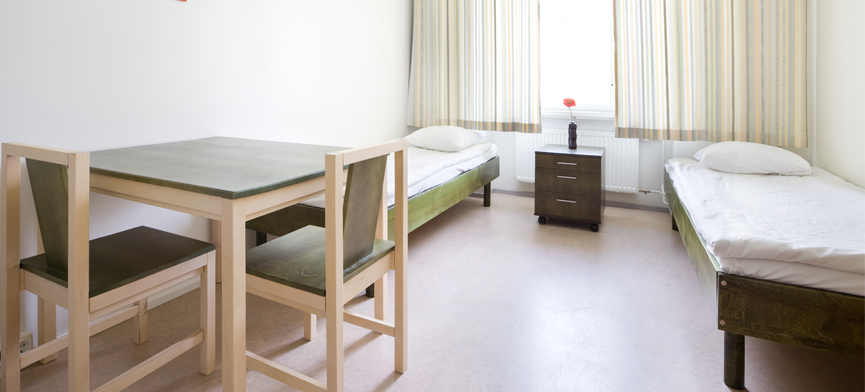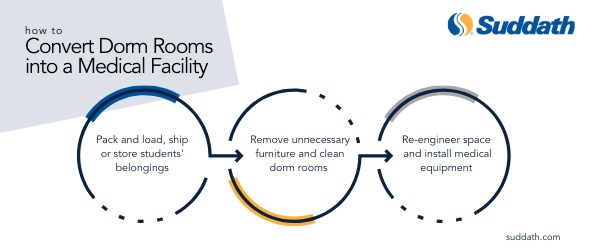
Transitioning Dorms into Temporary Medical Facilities
As the United States continues to weather the COVID-19 pandemic, a growing number of communities are looking to turn unused spaces into temporary medical facilities. Facilities of all types, including old hospitals, cruise ships and hotels have been considered. As schools around the nation continue to announce either complete closure or online courses only, dorms have become a viable option as temporary housing for patients and healthcare workers.
Government officials like New York Governor Andrew Cuomo and New Jersey Governor Phil Murphy proposed using dorm rooms earlier this year to help to meet medical demand. As the nation continues to battle the virus and with the uncertainty surrounding a fall resurgence, many hospitals may continue to need additional support.
When considering transitioning dorms into medical spaces, it’s important to understand the steps to the process, and how to make sure you’re working with the right experts to make the transition as seamless as possible.

Recovering Students’ Belongings
Many college campuses were brought to an abrupt halt in March when COVID-19 began sweeping the nation. Students left campuses without a clear idea when or if the school year would resume. This has created an issue for schools because these students may still have personal items in their dorm room that need to be packed, loaded into vehicles or temporarily stored, before the space can be converted into a temporary medical facility.
Innovators like Suddath® were quick to create solutions to help students and colleges safely get personal items out of dorm rooms. Students can book a virtual move using video confirmation to ensure all items are accounted for. After items are packed, they can be loaded in a vehicle, shipped to students or stored. Packed items can also be digitally tracked and inventoried using Suddath’s Tracker technology. Unique QR coded labels are issued and attached to the student’s items, upon retrieval all belongings can quickly be scanned to ensure all items are accounted for and returned. When removing personal items for thousands of students, this process helps quickly and safely remove belongings without putting them at risk by entering the dorms or expecting them to return to campus to retrieve items, and streamline the process, making it faster to convert dorms into temporary medical facilities.
Furniture Removal and Cleaning
Once personal items are removed, the next step in the process is to remove any remaining unnecessary furniture to make room for medical equipment, as well as clean the rooms to ensure a safe, sanitized space. Immediate temporary storage will be critical for housing any unused furniture or school items until the rooms can be transitioned back into student housing.
Space Converting and Installing Medical Equipment
While some colleges are being looked at to house patients, others have been talked about as options to be a safe space for medical workers to stay if they are not comfortable going home to their families while treating ill patients.
One of the struggles about turning dorm rooms into temporary medical facilities is that the space is not designed like a hospital room. Arranging these rooms to maximize space is essential. That’s why colleges and medical facilities need space experts to make sure the dorm rooms are laid out properly to allow for all necessary equipment, as well as clear walkways for healthcare workers to perform essential duties.
Reconverting Space for the New School Year
While it remains unclear how long this pandemic will impact the nation, the hope is that dorms used as temporary medical facilities will transition back to student housing again in the fall. When the space is reconverted to dorm rooms, many of the same steps will come into play. Colleges will need to work with experts to remove medical equipment, sanitize rooms, remove items from temporary storage and reassemble rooms to be used by students.
Depending on how the situation evolves, this may need to be completed in a very short timeframe. Colleges will want to make sure they have a streamlined process and trusted professionals that can meet their timeline to be prepared to serve students in the fall.
A Partner that Does it All
Suddath has the specialized tools, techniques and technology to handle this unique transition. As experts in healthcare and higher education relocations, we can help hospitals and colleges with all services necessary to transition dorms into temporary medical facilities, making the process easier and faster. Our commercial moving services include recovering students’ personal items, cleaning furniture removal, temporary storage, room reconfiguration, medical equipment moving and installation and much more. Fill out our form to talk to one of our experts.